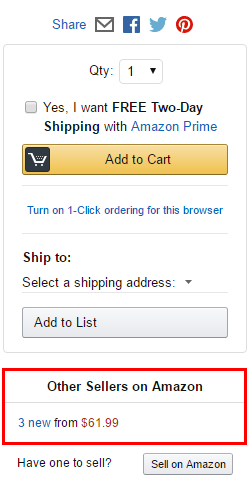Online marketing is in a constant state of flux and it’s vital to keep up to date with current trends to avoid falling behind the competition. And however you market your products on the internet, you can’t avoid Amazon. Why? Because Amazon is the leading product search engine for users with a clear intention to buy. You’ll know from your own experience that when you know exactly what you’re after, you don’t type it into Google; you head straight to Amazon because you’re bound to find it there. Quickly, easily and reliably.
Can I be successful with any product on Amazon?
In principal, yes – Amazon’s portfolio of products is huge. Of course there will always be certain types of products which sell better than others but this is where testing and analysis come in. Personally, I prefer a combination of the two. There are a range of tools available which can help you estimate the success of a product on Amazon, whether using competitor analysis or classification by sales rank. The lower a product’s sales rank value, the better it tends to sell within its category – giving you an idea of competition and demand.
Should I make my entire online shop catalogue available on Amazon?
Not straight away. It’s certainly tempting to offer your entire catalogue on Amazon using a product management interface or via a classic table import but there are bound to be products included which simply aren’t worth selling on Amazon. Online marketing offers all sorts of quick and uncomplicated solutions which may be easy but remain one-size-fits-all solutions. Success requires hard work to find tailored solutions, which don’t materialize overnight.
Initially, focus your energy on your top-sellers and biggest margins and promote them on Amazon. This will enable you to maintain an overview and make observations based on which you can remove products from sale or add new ones. A further advantage of only offering an exclusive selection of your catalogue is that you can optimize specifically for these products, giving you a better chance of staying ahead of the competition than you would otherwise have with a more general solution.
What steps should I take to optimize my product listing?
Before you start optimizing for Amazon, it’s important to know what Amazon itself wants – and this is not necessarily product sales but rather long term customer loyalty. The products listed highest by Amazon are those which offer the buyer the best possible shopping experience – both in terms of suitability of search result and overall user experience. A product which responds to a search query 100% but which frequently suffers from delayed delivery or similar issues will not rank high because the consumer will not return.
Amazon’s algorithm is based on two main sets of factors – relevance and performance. The relevance factors are self-explanatory. Product listings must be relevant to the search query and can be easily controlled by applying the correct product title, attribute, key words and description. Here are four ideal opportunities to apply your keywords and semantic search terms to ensure that Amazon includes them in its product evaluation.
Unlike in classic SEO, Amazon isn’t looking for keyword frequency but rather for keyword positioning. Amazon evaluates these four fields in the order given above. Your most important keyword therefore should always appear in the title whilst further keywords should be placed in the attributes, search terms or description. Be careful not to use too many different keywords in your product title as this will only weaken your product’s standing. You need to find a balance between ranking highly for one keyword, perhaps because the competition is particularly strong for it, or accepting a lower relevance for several different keywords. The latter can be a useful strategy when the competition doesn’t rank that highly.
Whilst you have a degree of control over your product relevance factors, performance factors such as sales figures, click-through-rate and conversion rate are less easy to influence. Simply put, of course, the higher the better! But the difficulty here is that these factors can only be improved when a product is well-placed or well-described with positive reviews and ratings, etc. The best way to improve your performance factors is therefore through skilful optimization of your relevance factors. The two are very much linked.
Can I just optimize any product, then?
Unfortunately not! Of course you can put any product on Amazon but you run the risk of either somebody else wanting to sell the same product or of Amazon classifying it alongside a rival brand because the products look identical. When this happens, it’s not as easy to influence the relevance factors because Amazon either removes your rights to the product and gives them to the competition – or vice versa. This swap can happen repeatedly and doesn’t help anybody. What’s more, it means a competitor is now offering the same product and the buyer is faced with two different merchants.
This is where the Buy Box comes into play – the shopping cart button on the product details page. Clearly, once a product has been added to the cart, only one seller can be listed to sell the product. If you are not the seller, the only way the buyer could access your offer would be via several additional clicks. When you consider that over 90% of buyers complete their purchase with the seller listed in the Buy Box, this puts you at a distinct disadvantage.

So how do I get in the Buy Box?
Amazon considers several influencing factors when calculating a rating, including:
- Price
- Delivery method
- Delivery time
- Sender reliability
- Order defect rate
- Customer reviews
- Reaction time
- Seller rating
Amazon uses these factors to calculate a score which either qualifies or disqualifies the seller for the Buy Box. Have a look at these two examples of how Amazon produces its score:
When choosing a delivery method, Amazon gives the seller a choice between sending via Amazon or sending independently. Since Amazon are well-placed in terms of delivery, the score for delivery via Amazon is 100 – the highest possible value. It’s difficult to reach that score with independent delivery, although it’s clear that Prime sellers have a significant advantage in this respect.
The second example concerns the seller rating – calculated based on the performance of the seller when carrying out an order. Every successfully completed order gets 100 points (in special cases even 110). Late delivery incurs a fine of -100 points, reviews of three stars or less – or even -500 points! It’s clear to see that Amazon places great value on happy customers. Allegedly, a seller rating of 95%+ is required to guarantee Buy Box status. It’s not impossible but it requires work to overcome certain hurdles. Customer satisfaction is paramount.
Rather than fighting over the Buy Box, should I stick to promoting unique products?
It depends! If you can commit the necessary time and effort to those aspects which boost your Amazon ranking, and if you are willing to enter into a price war, then it’s definitely worth aiming for the Buy Box. And there are number of tools out there which can help.
If your own stats make for hard reading, it’s because most sales are being placed with the competition. Check exactly how often your product sells and decide whether it’s worth dropping your price or delivery costs to catch up with the competition. A product which only sells ten pieces a month probably isn’t worth optimizing but a product which is sold 100 times a month, of which 90 via the competition, is worth taking a closer look at.
Unique products on the other hands offer greater scope for targeted optimization of relevance factors to boost your rankings. You have much more control over such products than over common, popular, BuyBox products.
It’s also possible to achieve a healthy mix of the two and to turn popular BuyBox products into unique, specialist items. Perhaps by adding a branded accessory which can’t be copied by your competitors. The possibilities are endless but the key to success is constant attention and optimization.
To sum up…
Amazon is not your competitor – it is an opportunity. I would advise everyone to offer at least part of their catalogue on Amazon, especially unique, exclusive products. I also recommend carrying out careful analysis and not to rush in blindly. If you don’t plan properly, Amazon can quickly lose its appeal.
Keep a constant eye on potential competition, click rates, conversion rates and average sales. Carry out small-scale tests to assess the market and keep track of broader trends.
Tools can help you to monitor key performance indicators for your products and those of your competitors. Use the figures, have faith in your product and be prepared to invest some time and effort, and success on Amazon won’t be far behind.

